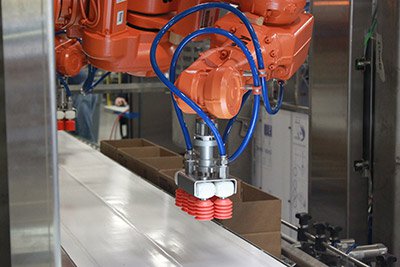
When Meat and Material Handling Equipment Meet
Aaron Jones | 03 April 2014
Food processing plants are required to be incredibly clean, so when installing material handling equipment, rules must be followed to ensure food safety.
When in review of some of the most demanding and extreme conditions that material handling equipment (MHE) can be subjected to, the applications can be quite daunting. There are machining and welding lines, heavy duty load and unload stations, fork truck interface stations, high speed and high precision applications, explosion proof lines, solvent application lines, etc., etc.
Despite all the smoke, fumes, dirt, grease, and grime, perhaps the most extreme applications for MHE can be found in one of the cleanest industries of all: meat and poultry processing plants.
Importance of Equipment Sanitation
As one in six Americans get sick from food poisoning each year, there remains a relentless focus on food safety across North America. With an increased knowledge and awareness of the threats of harmful bacteria, the number of reported food poisoning cases in America have decreased from 76 million down to 48 million cases annually, and from 5,000 to 3,000 annual deaths.
At the food product level, restaurants and stores are focusing on the preparation and cooking of ready to eat foods, but the concern for sanitation and harmful bacteria prevention starts before food even reaches these locations. The focus starts at the MHE level.
As the demand for facility automation continues its dominance over 21st century manufacturing facilities, meat and poultry processing plants have become leaders in the use and application of high end automation. With implementation of these automated systems, companies are now able to produce, store, pick, pack, palletize, and ship at production rates previously not obtainable.
Today’s advances in robotic vision systems, metal detection, manufacturing execution systems (MES) / Supervisory Control and Data Acquisition (SCADA), and automated storage and retrieval systems allow full functionality and turnkey automation. As the capabilities of automation continue to develop, so must the robustness of the equipment in allowing frequent caustic sanitation to prevent all forms of contamination.
The necessity to perform intense daily high end sanitation drives detailed, top line equipment design. As there is not one common design for each and every form of food grade equipment, the design features below seem to be common characteristics across many food material handling equipment applications.
Common characteristics of food-grade material handling equipment:

- Eliminate as many hollow tubes as possible by utilizing structural channel or angle
- Rotate cross members at a 45 degree angle so cleaning solutions do not remain on the equipment after the cleaning cycle
- Sprocket guards should be open in design, allowing high pressure wash down without removal
- Ground and buffed welds, fully passivated after welding is complete
- Fastener locations should include standoffs, eliminating a direct harborage point
- Equipment joints shall be filled with a food-grade, high-temperature silicon
- Floor anchors and supports grouted and sealed, prohibiting bacteria penetration
- Utilization of sensing devices that are not inhibited by cleaning solutions or steam
- Avoid placing mechanical equipment directly over food processing areas
- Fasteners should also not to be used over food processing areas
- Use of cantilevered conveyor design for ease of belt cleaning and maintenance
- 304 stainless steel construction with varying finishes depending on level of food contact
- Machinery and chain guards should drain away from food product zones
- Installation should maintain an 18” floor clearance
- All open surfaces should be designed to prevent the pooling of water
- The use of name plates and placards is minimized
A focus on food safety and improved sanitation processes continues to dominate discussions in food plants across North America. This means facility automation and equipment integrators must fully understand the consequences of an improper equipment application. An improper application, meaning one that is not designed for the highest of sanitation standards, cannot be utilized in today’s food processing plants. Deviating from the highest of equipment standards leads to severe results, such as increasing the already prevalent sickness and death statistics.
When meat and material handling equipment meet, it’s critical to adhere to the strictest of sanitation standards. If you are looking to automate your food processing line, be sure to research and choose a material handling integrator with experience in the field.
President & CEO of Bastian Solutions.
Comments
Luca Fontana says:
8/28/2018 10:09 AM
Also pay attention to differences on specifications overseas. EU regulations on this subject are way different from the USDA. Some common ground discussion should be made by machines mannifacturers on both sides of th ocean.
David Ryan says:
8/28/2018 10:09 AM
Nice blog, Thanks for share this informative blog.
Leave a Reply
Your email address will not be published.
Comment
Thank you for your comment.